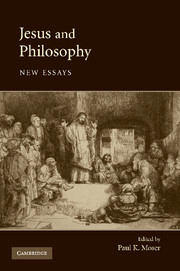Book contents
- Frontmatter
- Contents
- Preface
- Contributors
- Introduction: Jesus and Philosophy
- PART ONE JESUS IN HIS FIRST-CENTURY THOUGHT CONTEXT
- 1 Jesus: Sources and Self-Understanding
- 2 Sipping from the Cup of Wisdom
- 3 The Jesus of the Gospels and Philosophy
- 4 Paul, the Mind of Christ, and Philosophy
- PART TWO JESUS IN MEDIEVAL PHILOSOPHY
- PART THREE JESUS IN CONTEMPORARY PHILOSOPHY
- Index
- References
1 - Jesus: Sources and Self-Understanding
Published online by Cambridge University Press: 05 June 2012
- Frontmatter
- Contents
- Preface
- Contributors
- Introduction: Jesus and Philosophy
- PART ONE JESUS IN HIS FIRST-CENTURY THOUGHT CONTEXT
- 1 Jesus: Sources and Self-Understanding
- 2 Sipping from the Cup of Wisdom
- 3 The Jesus of the Gospels and Philosophy
- 4 Paul, the Mind of Christ, and Philosophy
- PART TWO JESUS IN MEDIEVAL PHILOSOPHY
- PART THREE JESUS IN CONTEMPORARY PHILOSOPHY
- Index
- References
Summary
To come to any credible conclusion with respect to Jesus's self-understanding, one must have access to credible sources. Fortunately, such sources are available. Indeed, historians have a wealth of sources, whose great number poses almost as many problems as presents opportunities for productive critical research. The sources themselves must be critically sifted, following the canons recognized by historians in weighing the value of documents that survive from antiquity. Some of these canons are little more than common sense. Many of them are reflected in what Jesus researchers often refer to as the “criteria of authenticity.”
The aim of the present chapter is twofold: (1) to identify and assess the sources that purport to impart information about the historical Jesus, and (2) to deduce from the most reliable sources what the historian can know about how Jesus understood himself and his mission.
SOURCES FOR THE STUDY OF THE HISTORICAL JESUS
The late antique sources for Jesus fall into three categories: Christian, Jewish, and pagan. It is not always easy to decide which sources belong in which category. For example, although many scholars readily assign Gnostic writings to Christianity, I am inclined to assign most of them to paganism (more on this later). Moreover, there is some overlap between the Christian and Jewish categories, in that many early Christian sources also derive from Jewish authors and faith communities.
- Type
- Chapter
- Information
- Jesus and PhilosophyNew Essays, pp. 27 - 40Publisher: Cambridge University PressPrint publication year: 2008



